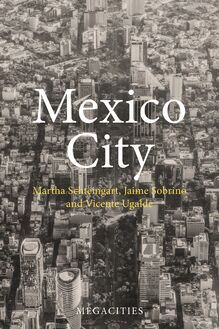-
 Univers
Univers
-
 Ebooks
Ebooks
-
 Livres audio
Livres audio
-
 Presse
Presse
-
 Podcasts
Podcasts
-
 BD
BD
-
 Documents
Documents
-
- Cours
- Révisions
- Ressources pédagogiques
- Sciences de l’éducation
- Manuels scolaires
- Langues
- Travaux de classe
- Annales de BEP
- Etudes supérieures
- Maternelle et primaire
- Fiches de lecture
- Orientation scolaire
- Méthodologie
- Corrigés de devoir
- Annales d’examens et concours
- Annales du bac
- Annales du brevet
- Rapports de stage
La lecture à portée de main
Vous pourrez modifier la taille du texte de cet ouvrage
Découvre YouScribe en t'inscrivant gratuitement
Je m'inscrisDécouvre YouScribe en t'inscrivant gratuitement
Je m'inscrisEn savoir plus
Vous pourrez modifier la taille du texte de cet ouvrage
En savoir plus

Description
Mexico City is the second largest city on the American continent, the most populous Spanish-speaking city in the world and the richest city, in terms of GFP, in Latin America. The authors explore the political structures, demography, economy, social issues and public administration that make this megacity distinctive.
Unique and vibrant, Mexico City has been run since the 1990s by left-wing parties with more progressive social and egalitarian concerns about urban problems, and new proposals for different types of state participation. Political changes at the city level has led to changes and fresh approaches in some aspects of social life, including the creation of important local, grass-roots institutions. The book offers quantitative and qualitative assessments of the spatial structure of the city and its distribution of poverty and poor economic outcomes, alongide transportation provision, housing. Deindustrialization and the growth of the service sector alongside an expanding informal economy are also shown to be important dynamics in the economic restructuring of the city.
Introduction: Mexico City as a Latin American megacity
1. Describing demographic change
2. Economic restructuring under globalisation
3. Links between housing, mobility, and transport
4. Territorial inequalities and segregation
5. Political change and the provision of public services
6. Environmental issues and natural risks
7. The city in search of an institutional solution
Conclusion: challenges and life opportunities in a megacity
Sujets
Public Policy
Political Economy
Sustainable Development
Political Science
Latin American
HISTORY
México, D. F.
México
América del Sur
Geography
Sustainability
Index of urban studies articles
South America
Mexico City
Latin America
Central America
Development
SS Central America
World
Mexico
Caribbean
Informations
| Publié par | Agenda Publishing |
| Date de parution | 09 février 2023 |
| Nombre de lectures | 0 |
| EAN13 | 9781788214605 |
| Langue | English |
| Poids de l'ouvrage | 4 Mo |
Informations légales : prix de location à la page 0,4750€. Cette information est donnée uniquement à titre indicatif conformément à la législation en vigueur.
Extrait
Mexico City
Megacities
Series Editor: H. V. Savitch
As drivers of economic growth, demographic change and consumption hyper-conurbations offer unique opportunities to their hinterlands and national economies, as well as huge challenges of governance, planning and provisioning. Each book in this series examines the political and economic development of a specific megacity and explores how and why they have evolved and how policy decisions, couched in geopolitics, have shaped their outcomes. The series covers both paradigmatic mature megacities of the developed world, as well as the fast-growing emerging megacities of South and East Asia, and Latin America.
Published
London
Mike Raco and Frances Brill
Mexico City
Martha Schteingart, Jaime Sobrino and Vicente Ugalde
New York
Jill S. Gross and H. V. Savitch
Paris
Christian Lefèvre
Mexico City
Martha Schteingart, Jaime Sobrino and Vicente Ugalde
© Martha Schteingart, Jaime Sobrino and Vicente Ugalde 2023
This book is copyright under the Berne Convention.
No reproduction without permission.
All rights reserved.
First published in 2023 by Agenda Publishing
Agenda Publishing Limited
The Core
Bath Lane
Newcastle Helix
Newcastle upon Tyne
NE4 5TF
www.agendapub.com
ISBN 978-1-78821-457-5
British Library Cataloguing-in-Publication Data
A catalogue record for this book is available from the British Library
Typeset by Newgen Publishing UK
Printed and bound in the UK by TJ Books
Contents
Acronyms
Introduction: Mexico City as a Latin American megacity
1 Describing demographic change
2 Economic restructuring under globalization
3 Links between housing, mobility and transport
4 Territorial inequalities and segregation
5 Political change and the provision of public services
6 Environmental issues and natural risks
7 The city in search of an institutional solution
Conclusion: challenges and life opportunities in a megacity
References
Index
Acronyms
Acronyms
Spanish
English
AGEB
Área Geoestadística Básica
Basic Geostatistical Area
AURIS
Instituto de Acción Urbana e Integración Social
Institute of Social Integration and Urban Action
BANOBRAS
Banco Nacional de Obras y Servicios
National Bank of Public Works and Services
CAM
Comisión Ambiental Metropolitana
Metropolitan Environmental Commission
CDMX
Ciudad de México
Mexico City
CECM
Comisión Ejecutiva de Coordinación Metropolitana
Executive Commission for Metropolitan Coordination
CETRAM
Centro de Transferencia Modal
Modal Transfer Centre
CODEUR
Comisión de Desarrollo Urbano y Ordenamiento Territorial
Urban Development and Territorial Planning Commission
COMETAH
Comision Metropolitana de Asentamientos Humanos
Metropolitan Commission of Human Settlements
COMETRAVI
Comisión Metropolitana de Transporte y Vialidad
Metropolitan Transportation and Highway Commission
CONAFOVI
Comisión Nacional de Fomento a la Vivienda
National Commission for Housing Development
CONAPO
Consejo Nacional de Población
National Population Council
CONEVAL
Consejo Nacional de Evaluación de la Política de Desarrollo Social
National Council for the Evaluation of Social Development Policy
CORETT
Comisión para la Regularización de la Tenencia de la Tierra
Commission for the Regularization of Land Tenure
DDF
Departamento del Distrito Federal
Department of the Federal District
DF
Distrito Federal
Federal District
DGHP
Dirección General de Habitaciones Populares
General Directorate of Popular Housing
DOF
Diario Oficial de la Federación
Official Gazette of the Federation
ENIGH
Encuesta Nacional de Ingresos y Gastos de los Hogares
National Survey of Household Income and Expenditure
FONDEN
Fondo de Desastres Naturales
Natural Disaster Fund
FOPREDEN
Fondo Nacional para la Prevención de Desastres Naturales
National Fund for the Prevention of Natural Disasters
FOVI
Fondo de Operación y Financiamiento Bancario a la Vivienda
Housing Operation and Bank Financing Fund
FOVISSSTE
Fondo de la Vivienda del Instituto de Seguridad y Servicios Sociales de los Trabajadores del Estado
Housing Fund of the Social Security and Services Institute for State Workers
GDF
Gobierno del Distrito Federal
Federal District Government
GDP
Producto Interno Bruto
Gross Domestic Product
GODF
Gaceta Oficial del Distrito Federal
Official Gazette of the Federal District
IMCO
Instituto Mexicano para la Competitividad
Mexican Institute for Competitiveness
IMD
Institute of Management Development
INDECO
Instituto Nacional para el Desarrollo Comunitario y de Vivienda
National Institute for Community and Housing Development
INEGI
Instituto Nacional de Estadística y Geografía
National Institute of Statistics and Geography
INFONAVIT
Instituto del Fondo Nacional de la Vivienda para los Trabajadores
Institute of the National Fund for Housing for Workers
INVI
Instituto de Vivienda de la Ciudad de México
Housing Institute of Mexico City
ISSFAM
Instituto de Seguridad Social para las Fuerzas Armadas Mexicanas
Social Security Institute for the Mexican Armed Forces
MORENA
Movimiento de Renovación Nacional
National Renovation Movement
NAFTA
Tratado de Libro Comercio de América del Norte
North America Free Trade Agreement
ONAVIS
Organismos Nacionales de Vivienda
National Housing Organizations
PAN
Partido Acción Nacional
National Action Party
PAOT
Procuraduría Ambiental y del Ordenamiento Territorial de la Ciudad de México
Environmental and Territorial Planning Office of Mexico City
PEMEX
Petróleos Mexicanos
Mexican Oil Company
PICCA
Programa Integral Contra la Contaminación Atmosférica
Comprehensive Programme Against Atmospheric Pollution
PRD
Partido de la Revolución Democrática
Democratic Revolution Party
PRI
Partido Revolucionario Institucional
Institutional Revolutionary Party
PROFEPA
Procuraduría Federal de Protección al Ambiente
Federal Attorney for Environmental Protection
RAMA
Red Automática de Monitoreo Ambiental
Automatic Environmental Monitoring Network
RTP
Red de Transporte de Pasajeros
Passenger Transportation Network
SACMEX
Sistema de Aguas de la Ciudad de México
Mexico City Water System
SEDATU
Secretaría de Desarrollo Agrario, Territorial y Urbano
Ministry of Agrarian, Territorial and Urban Development
SEDEMA
Secretaría del Medio Ambiente
Ministry of the Environment
SEDESOL
Secretaría de Desarrollo Social
Ministry of Social Development
SEMARNAT
Secretaría de Medio Ambiente y Recursos Naturales
Ministry of the Environment and Natural Resources
SIMAT
Sistema de Monitoreo Atmosférico de la Ciudad de México
Atmospheric Monitoring System of Mexico City
SOFOLES
Sociedades Financieras de Objeto Limitado
Limited Purpose Financial Companies
STCM
Sistema de Transporte Colectivo Metro
Metro Collective Transportation System
ZMCM
Zona Metropolitana de la Ciudad de México
Mexico City Metropolitan Area
INTRODUCTION
Mexico City as a Latin American megacity
Urbanization and megacities
Major cities in Latin America and the Caribbean have undergone profound changes since the end of the past century. From the postwar period to the 1980s, the largest metropolitan agglomerations in the region led the economic expansion of their respective countries, expanding and enhancing their productive capacities. These metropolitan areas achieved significant social, economic, political and urban progress, concentrating large educational and health facilities, and becoming the main destination for internal migration flows. Latin America became one of the most urbanized regions in the world, second only to North America. By 2020 this subcontinent was home to six megacities with more than ten million residents each: São Paulo, Mexico City, Buenos Aires, Rio de Janeiro, Bogotá and Lima.
Urban and metropolitan development in Latin America and the Caribbean has experienced structural problems linked to their relative capacity for labour absorption, social housing availability, urban growth management and planning, challenges for the metropolitan government and administration, and issues with advancing sustainable urban development. Likewise, the financial, technical and institutional capacities for managing large cities and metropolitan areas have been insufficient to cope with their explosive growth, driven by the migration of citizens often expelled from their places of origin and with limited training or few opportunities to deal with the challenges of their new habitat. Urban management has failed to ensure that the city expands on the most appropriate land or overcomes its structural limitations in terms of housing, infrastructure, facilities and services.
These changes have been described from various perspectives in the specialized literature (Aguilar & Escamilla 1999 ; De Mattos 2010 ; Duhau & Giglia 2016 ; Rodríguez 2019 ; Ward 2004 ). The main ones include: (1) concentrated decentralization; (2) large-scale suburban expansion coupled with spatial diffusion and fragmentation processes; (3) social diversification and increasing inequalities on the periphery; (4) housing renovation through the recovery of residential areas and therefore migratory attraction from central areas, sometimes in conjunction with gentrification or similar phenomena; (5) changes in the type and intensity of segregation, and (6) increased daily mobility.
Cities are not self-sufficient, meaning that they require functional links and interdependence with other localities. Economic interrelationships between cities are more intense at the capitalist stage of globalization, which has been analysed under the concept of the world network of metropolis (Sassen 2000 ). Interdependencies are the result of the new international division of labour, technological development, the computer age, and emerging forms of daily mobility of the population, objects and ideas. Within Mexico, these manifestations have given rise to urban or metropolitan regions,
-
 Univers
Univers
-
 Ebooks
Ebooks
-
 Livres audio
Livres audio
-
 Presse
Presse
-
 Podcasts
Podcasts
-
 BD
BD
-
 Documents
Documents
-
Jeunesse
-
Littérature
-
Ressources professionnelles
-
Santé et bien-être
-
Savoirs
-
Education
-
Loisirs et hobbies
-
Art, musique et cinéma
-
Actualité et débat de société
-
Jeunesse
-
Littérature
-
Ressources professionnelles
-
Santé et bien-être
-
Savoirs
-
Education
-
Loisirs et hobbies
-
Art, musique et cinéma
-
Actualité et débat de société
-
Actualités
-
Lifestyle
-
Presse jeunesse
-
Presse professionnelle
-
Pratique
-
Presse sportive
-
Presse internationale
-
Culture & Médias
-
Action et Aventures
-
Science-fiction et Fantasy
-
Société
-
Jeunesse
-
Littérature
-
Ressources professionnelles
-
Santé et bien-être
-
Savoirs
-
Education
-
Loisirs et hobbies
-
Art, musique et cinéma
-
Actualité et débat de société
- Cours
- Révisions
- Ressources pédagogiques
- Sciences de l’éducation
- Manuels scolaires
- Langues
- Travaux de classe
- Annales de BEP
- Etudes supérieures
- Maternelle et primaire
- Fiches de lecture
- Orientation scolaire
- Méthodologie
- Corrigés de devoir
- Annales d’examens et concours
- Annales du bac
- Annales du brevet
- Rapports de stage








